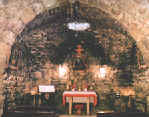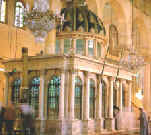|
|
DAMASCUS:
The world's oldest continuously inhabited city. Many civilizations have left their mark on Damascus over the centuries: Aramaic, Greek, Roman, Byzantine, Arab.
MOST IMPORTANT SITES
The Umayyad Mosque, Azem palace, the House of St. Ananias, St. Paul's window, National Museum, Al -Takieh, Hamidiyah Bazaar, Saladin's Mausoleum, Street Called Straight. At 60 km north of Damascus: MA'ALULA, the spectacular village, carved in the mountain, where people still speak Aramaic, the language of Jesus Christ.
ALLEPPO
360 km. (220 miles) north of Damascus. Fabled city of a long history of glory and prosperity since the 3rd millennium B. C. (The legend holds that prophet Abraham once milked his cow atop its hill.) Until our own century. Aleppo dominated the trade routes connecting East and West. Today, this second largest Syrian city
still plays a key economic role. Most important sites: the Citadel, Khans (inns), medieval Suqs (which are covered and wind through the old city for more than 12 km (8 miles), Grand Mosque, National Museum.
HOMS
160 Km. (100 miles) north of Damascus. Since ancient times its midway location (between Damascus and Aleppo, Palmyra and the Mediterranean) has made it a principal crossroads. Today Homs still plays a similar role as a crossing point for pipelines. It contains an important oil refinery and many major factories, plants and mills. Two famous Roman emperors (Elagabal, Alexander Severus) originated from Homs. Important sites: Ibn Al-Walid Mosque, the Virgin's Belt Church, St.Elian Church.
HAMA
140 km. (90 miles) south of Aleppo. An old and timeless city famed by its Norias- the huge wooden waterwheels that have been scooping water from the Orontes and pouring it into irrigation canals for centuries. Important sites: Museum, Grand Mosque. At 55 km.(35 miles) north-west: the ruins of APAMEA,
the ancient Greco - Roman city built in 300 B.C. It was a very prosperous settlement inhabited at one time by nearly half a million people.
LATAKIA
186 km. (120 miles) south -west of Aleppo. One of the 5 cities built in the 3rd century B.C. by Seleucos Nicator. Today it is Syria's principal port on the Mediterranean, and a starting point for excursions to summer resorts,
medieval castles and archeological sites in the surrounding mountains and the coastline area.
PRINCIPAL SITES:
ANCIENT KINGDOMS
UGARIT (RAS SHAMRA): 16km. north of Latakia. In 16th century B.C. it was an apogee in culture, diplomacy, administration, religion and economy. Its brilliant invention was the world's first alphabet. The 30-letter inscription on a finger size clay tablet soon revolutionized human knowledge and became the basis of western alphabets.
MARI (TELL HARIR): Dates from the 4th millennium B.C. its strategic location on the Euphrates made it a prosperous and powerful kingdom. When discovered in 1933, a 300-room palace was unearthed.
EBLA (TELL MARDIKH): 40 km. (25 miles) south of Aleppo. Brought to light in 1974. It was a prominent kingdom in the 25 th century B.C. Excavations uncovered its palace library of over 17.000 clay tablets. Among these was the world's earliest bilingual dictionary.
PALMYRA (TADMOR): 150km. (90 miles) east of Homs. It rises abruptly from the desert as a dreamlike oasis. A jumble of magnificent ruins whispering of the grandeur of this metropolis which, in the 3rd century A.D., was rules by the extraordinary Queen Zenobia. Principal sites: The Temple of Bell, Arch of Triumph, Senate, Agora, Theater and the Museum.
MOST IMPORTANT CASTLES
KRAK DES CHEVALIERS, 65 km. (40 miles) west of Homs;
SALADIN'S, 35 km. (21 miles) east of Latakia;
AL-MARQAB, 95 km. (60 miles) south-east of Latakia;
One of the world's best preserved Greco-Roman amphitheaters is at BOSRA 120 km. (75 miles) south of Damascus. Built in the 2nd century. It seats 15.000 people.
Ministry of tourism, Damascus
Tel.: (+963)221 - 0122
Fax: (+963)224 - 2636

St. Annie Chapel, Damascus

Omayad Mosque, John's Tomb, Damascus
|
|


